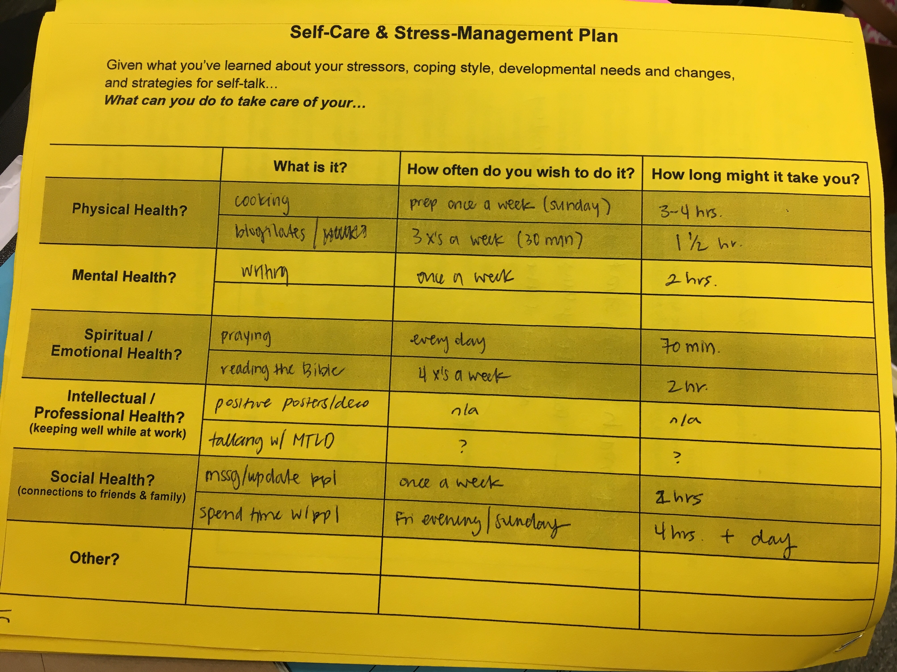I only invite guest posts around here if I am positive it will add value to my Together readers. You all know I believe sustainability in your roles matters a ton. And your jobs are STRESSFUL. We have discussed how to manage that a bit here and here. Well, meet Marin Smith, teacher-turned-principal-turned-licensed clinical social worker. Marin works with college students by day and teachers by night and weekend. Read on for how to create your own Self-Care Menu. I LOVE this.
The term Self-Care gets thrown around a lot.
Self-Care includes SO many strategies for improving or maintaining physical and mental health, managing stressors, strengthening relationships, and nourishing ourselves.
It’s also a bit like an independent study. For one person, practicing good Self-Care might look like maintaining an exercise routine, attending church, and going to happy hour. For another it might mean reading a book, taking a walk, or calling a sibling.
The Self in Self-Care is also really important. These are things we do for ourselves. While other people may occasionally provide opportunities for Self-Care — perhaps your school hosts a holiday potluck or a friend invites you to take a walk — our Self-Care almost always needs to be initiated, acted upon and driven by us. This can be what’s awesome about it — look at all the great things we get to do for ourselves! — as well as what’s so difficult – because no one else is going to make it happen for us.
But one pitfall with Self-Care is our tendency to think of it in black and white terms. Subjectively, we feel we’re either doing awesome with it, or it’s going terribly. We might believe our organization supports Self-Care, or doesn’t value us as people at all. One week, we’re taking amazing care of ourselves; the next, we’re doing an awful job. And so on.
So here comes the Together part: Like any habit, explicitly planning for how and when Self-Care is going to happen will make it that much more likely to be successful.
We may not be able to do everything we want to do at all times, but we can do a lot. Or some. We can practice “good enough” Self-Care.
Enter the Self-Care Menu:

To download the PDF printable, click here! Once you click the link, be sure to right-click on the document and select “Download.”
Thinking of Self-Care as a menu of options can help us set more realistic goals for ourselves. Instead of exercising every day, maybe we get flexible and instead aim for 2-3 times per week, for 30-45 minutes each time.
When we plan out our Self-Care times explicitly, and get clear with ourselves about how much we can accomplish and when, rather than waiting or hoping for the just right amount of time to magically open up, Self-Care is MUCH more likely to happen. And we’re MUCH more likely to feel more sustained, capable and empowered—in all parts of our life.
Remember: Self-Care can be as big and bold as a vacation, a hike, a special date-night out, or a shopping trip. But it can also be as small and as quiet as having a cup of tea upon arriving home, journaling, cuddling, hydrating, or reading. Creating a balanced plan for yourself, that includes activities both big and small, special treats as well as daily routines, is key.
As you’re working on your own self-care menu, consider the following:
- Try to fill in at least 4 boxes in the “What Is It” column (you needn’t fill in every section!)
- Think about how often you realistically want to engage in each activity
- Give yourself a clear estimate of how long each activity might take
In the Comments section below, let’s see if we can build an awesome Together menu of Self-Care ideas. Tell us: What will you do to take care of yourself this week? Bonus Points! Also share when you’re planning on doing this, and how long it will take.
Some examples:
- Walk home from work (5:00 — 5:45 PM on Tuesday)
- Have a cup of tea and read a magazine (9:00 — 9:30 PM on Thursday, after class)
- Go to class at gym (9:00 — 10:30 AM on Saturday)
- Do 5-minute mini-meditation (Prep periods on Monday and Wednesday)


